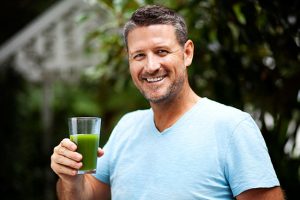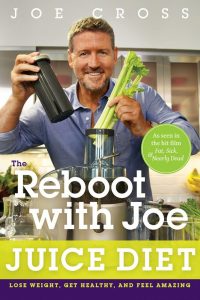
Joe Cross
Recipe 1: Joe’s Mean Green Juice
Ingredients
- 1 cucumber
- 4 celery stalks
- 2 apples
- 6-8 leaves kale
- 1/2 lemon
- 1 tbsp ginger
Wash all produce well. Peel the lemon and the juice. Pour over ice and enjoy!

Joe Cross
Recipe 1: Joe’s Mean Green Juice
Ingredients
Wash all produce well. Peel the lemon and the juice. Pour over ice and enjoy!
 You’ve seen Fat, Sick & Nearly Dead. Now you’re ready to do what Joe did. Here’s how to get started and on your way to weight loss and health!
You’ve seen Fat, Sick & Nearly Dead. Now you’re ready to do what Joe did. Here’s how to get started and on your way to weight loss and health!
First, let’s break it down for you…
A period of time where you commit to drinking and eating only fruits and vegetables, herbal teas and water in order to regain or sustain your vitality, lose weight and kick-start healthy habits that recharge your body and get your diet back in alignment for optimal wellness.
Yes, Joe drank juice for 60 days but then he followed those 60 days with three months of eating and drinking fruits and vegetables. Sixty days is extreme but Joe was in an extreme situation. You do not need to juice-only for 60 days or even only juice to benefit from a Reboot.
During a Reboot, you’ll commit to consuming only fruit and vegetable juices for a period of time. 3 days, 5 days, 15 days, 30 days? It’s your choice! The goal is to help you break a cycle of an unhealthy lifestyle and simply enhance the quality of your diet by increasing your intake of fruits and vegetables.
 Chef Andrew Parker has a message for post secondary students as they’re getting settled into their back to school routine.
Chef Andrew Parker has a message for post secondary students as they’re getting settled into their back to school routine.
“Ditch the instant noodles and get cooking!”
Chef Parker has come up with a variety of fast and easy recipes perfect for any student’s busy study schedule.
Using space-saving and budget-friendly small appliances like the Big Boss Grill Set and Crock Pot 4.5 Quart Slow Cooker, students can make a variety of fast, healthy and affordable meals.
Cooking is also great stress relief for students needing a brain break.
Here are two great dishes from Chef Parker that are perfect for a study session!
 Crock Pot Pulled Pork
Crock Pot Pulled Pork
Here’s yet another reason to be cautious about jumping on the ASA bandwagon. A study has linked the regular use of ASA with a higher risk of age-related macular degeneration or AMD, a very debilitating form of eye disease in which the central part of the retina, the macula, is gradually destroyed, which leads to progressive inability to see.
In this European study, people who took ASA regularly had roughly double the risk of “wet” AMD, the most serious form of the condition, compared to people who weren’t taking ASA.
Now, for many people, the benefits of taking ASA may – probably do – still outweigh the risks, but the key thing to remember is that there is no formula for this and the best thing to do (it should be mandatory, I think) is that anyone taking ASA regularly sit down and have a good discussion with their primary care doctor about the balance between the risks and benefits of ASA for their particular unique situation.

TV gets a very bad rap when it comes to assigning blame for our evident problems with obesity. Study after study has concluded that people who watch TV weigh way more than non-TV watchers. The former do less exercise, and they also tend to have much worse diets.
But two very key questions that remain unanswered by most of these studies are these: is it the TV watching that leads to the poorer health habits? Or do people with poor health habits choose to watch more TV?
And second, are all TV watchers equally at risk?
Well, seems to me that if there were no TV around, people who want to sit and eat fatty snacks would find other ways to fulfill their needs so I have long tended to absolve TV of much of the blame for why we’re fat and lazy (and yes, perhaps my views are coloured by the fact that I work on TV).
But there is a bit of evidence now to point to in order to back up what I believe: A European study published in the International Journal of Public Health has concluded that “news junkies” (mostly from TV, but also those who follow news on radio and in the press), tend to have healthier diets (specifically, they adhere more closely to a Mediterranean diet) than do people who are not avid news followers, which translates into eating more fruit and more fresh fish while consuming less meat.
In other words, TV viewing can actually improve health outcomes, which is why if you’re not doing it already, you should make a resolution to never – never, never – miss another episode of Health Headlines with Dr. Art Hister on Global TV.
Just suggesting this for your health, of course.

The good news is that you can lower your risk of stroke.
The bad news, at least for some of you, is that you have to eat your veggies.
A study (published in the journal Stroke: Journal of the American Medical Association) involving over 30,000 Swedish women, some of whom had pre-existing cardiovascular disease, found that those who ate the best diet in terms of anti-oxidant intake had a significantly lower risk of stroke than women who ate a poorer diet, which is no surprise, of course.
But what is a bit of a surprise is that the women eating an anti-oxidant-rich diet had a lower risk of stroke even if they had a history of heart disease.
In other words, and this should be no surprise, the people who likely gain the most from starting to follow a healthy health practice, which in this case is to eat your veggies, are also likely to gain the most from making that change.
Which doesn’t mean, of course, that those of us who are already doing the right things don’t have to emphasize doing them as much – it’s just that we start from a better place in that dash to live longer and healthier, so we don’t have nearly as much to gain from improving what we are already doing.